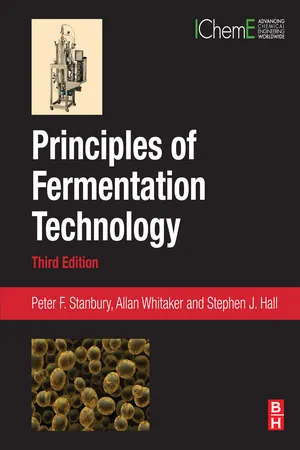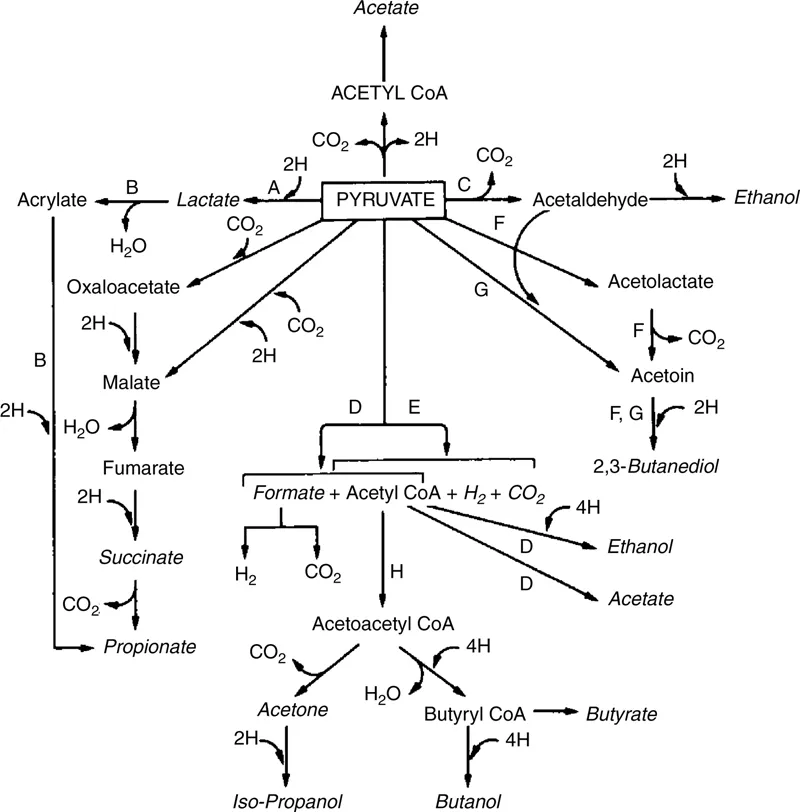
eBook - ePub
Principles of Fermentation Technology
- 824 pages
- English
- ePUB (mobile friendly)
- Available on iOS & Android
eBook - ePub
Principles of Fermentation Technology
About this book
The successful structure of the previous edition of Principles of Fermentation Technology has been retained in this third edition, which covers the key component parts of a fermentation process including growth kinetics, strain isolation and improvement, inocula development, fermentation media, fermenter design and operation, product recovery, and the environmental impact of processes. This accurate and accessible third edition recognizes the increased importance of animal cell culture, the impact of the post-genomics era on applied science and the huge contribution that heterologous protein production now makes to the success of the pharmaceutical industry.
This title is ideally suited for both newcomers to the industry and established workers as it provides essential and fundamental information on fermentation in a methodical, logical fashion. Stanbury, Whitaker and Hall have integrated the biological and engineering aspects of fermentation to make the content accessible to members of both disciplines with a focus on the practical application of theory. This text collates all the fermentation fundamentals into one concise reference, making it a valuable resource for fermentation scientists, as well as those studying in the field.
- Retains its successful structure and covers all components of the fermentation process
- Integrates the biological and engineering aspects of fermentation to discuss the most recent developments and advancements in the field
- Written in a style accessible to readers from either a biological or engineering background with each chapter supported by an extensive bibliography
Frequently asked questions
Yes, you can cancel anytime from the Subscription tab in your account settings on the Perlego website. Your subscription will stay active until the end of your current billing period. Learn how to cancel your subscription.
At the moment all of our mobile-responsive ePub books are available to download via the app. Most of our PDFs are also available to download and we're working on making the final remaining ones downloadable now. Learn more here.
Perlego offers two plans: Essential and Complete
- Essential is ideal for learners and professionals who enjoy exploring a wide range of subjects. Access the Essential Library with 800,000+ trusted titles and best-sellers across business, personal growth, and the humanities. Includes unlimited reading time and Standard Read Aloud voice.
- Complete: Perfect for advanced learners and researchers needing full, unrestricted access. Unlock 1.4M+ books across hundreds of subjects, including academic and specialized titles. The Complete Plan also includes advanced features like Premium Read Aloud and Research Assistant.
We are an online textbook subscription service, where you can get access to an entire online library for less than the price of a single book per month. With over 1 million books across 1000+ topics, we’ve got you covered! Learn more here.
Look out for the read-aloud symbol on your next book to see if you can listen to it. The read-aloud tool reads text aloud for you, highlighting the text as it is being read. You can pause it, speed it up and slow it down. Learn more here.
Yes! You can use the Perlego app on both iOS or Android devices to read anytime, anywhere — even offline. Perfect for commutes or when you’re on the go.
Please note we cannot support devices running on iOS 13 and Android 7 or earlier. Learn more about using the app.
Please note we cannot support devices running on iOS 13 and Android 7 or earlier. Learn more about using the app.
Yes, you can access Principles of Fermentation Technology by Peter F Stanbury,Allan Whitaker,Stephen J Hall,Peter F. Stanbury,Stephen J. Hall in PDF and/or ePUB format, as well as other popular books in Technology & Engineering & Chemical & Biochemical Engineering. We have over one million books available in our catalogue for you to explore.
Information
Chapter 1
An introduction to fermentation processes
Abstract
This chapter introduces the reader to the fermentation industry and lays the foundation for the rest of the book. The range of products manufactured by fermentation is discussed followed by an explanation of the chronological development of the industry and the six key steps in its evolution, from the production of organic solvents to recombinant proteins and animal cell processes. A “typical” fermentation is then described in terms of its component parts, or unit operations, enabling the reader to place the content of the subsequent chapters in the context of the whole process. Finally, the rationale adopted by the authors is explained and the reader is guided through the contents of the book.
Keywords
fermentation
biomass
primary metabolite
secondary metabolite
recombinant products
transformation processes
batch culture
continuous culture
fed-batch culture
The term “fermentation” is derived from the Latin verb fervere, to boil, thus describing the appearance of the action of yeast on the extracts of fruit or malted grain. The boiling appearance is due to the production of carbon dioxide bubbles caused by the anaerobic catabolism of the sugar present in the extract. However, fermentation has come to have with different meanings to biochemists and to industrial microbiologists. Its biochemical meaning relates to the generation of energy by the catabolism of organic compounds, whereas its meaning in industrial microbiology tends to be much broader.
The catabolism of sugar is an oxidative process, which results in the production of reduced pyridine nucleotides, which must be reoxidized for the process to continue. Under aerobic conditions, reoxidation of reduced pyridine nucleotide occurs by electron transfer, via the cytochrome system, with oxygen acting as the terminal electron acceptor. However, under anaerobic condition, reduced pyridine nucleotide oxidation is coupled with the reduction of an organic compound, which is often a subsequent product of the catabolic pathway. In the case of the action of yeast on fruit or grain extracts, NADH is regenerated by the reduction of pyruvic acid to ethanol. Different microbial taxa are capable of reducing pyruvate to a wide range of end products, as illustrated in Fig. 1.1. Thus, the term fermentation has been used in a strict biochemical sense to mean an energy-generation process in which organic compounds act as both electron donors and terminal electron acceptors.

Figure 1.1 Bacterial Fermentation Products of Pyruvate
Pyruvate formed by the catabolism of glucose is further metabolized by pathways which are characteristic of particular organisms and which serve as a biochemical aid to identification. End products of fermentations are italicized (Dawes & Large, 1982).
A, Lactic acid bacteria (Streptococcus, Lactobacillus); B, Clostridium propionicum; C, Yeast, Acetobacter, Zymomonas, Sarcina ventriculi, Erwinia amylovora; D, Enterobacteriaceae (coli-aerogenes); E, Clostridia; F, Klebsiella; G, Yeast; H, Clostridia (butyric, butylic organisms); I, Propionic acid bacteria.
Pyruvate formed by the catabolism of glucose is further metabolized by pathways which are characteristic of particular organisms and which serve as a biochemical aid to identification. End products of fermentations are italicized (Dawes & Large, 1982).
A, Lactic acid bacteria (Streptococcus, Lactobacillus); B, Clostridium propionicum; C, Yeast, Acetobacter, Zymomonas, Sarcina ventriculi, Erwinia amylovora; D, Enterobacteriaceae (coli-aerogenes); E, Clostridia; F, Klebsiella; G, Yeast; H, Clostridia (butyric, butylic organisms); I, Propionic acid bacteria.
The production of ethanol by the action of yeast on malt or fruit extracts has been carried out on a large scale for many years and was the first “industrial” process for the production of a microbial metabolite. Thus, industrial microbiologists have extended the term fermentation to describe any process for the production of product by the mass culture of a microorganism. Brewing and the production of organic solvents may be described as fermentation in both senses of the word but the description of an aerobic process as a fermentation is obviously using the term in the broader, microbiological, context and it is in this sense that the term is used in this book.
The range of fermentation processes
There are five major groups of commercially important fermentations:
1. Those that produce microbial cells (or biomass) as the product.
2. Those that produce microbial enzymes.
3. Those that produce microbial metabolites.
4. Those that produce recombinant products.
5. Those that modify a compound that is added to the fermentation—the transformation process.
The historical development of these processes will be considered in a lat...
Table of contents
- Cover
- Title page
- Table of Contents
- Copyright
- Dedication
- Acknowledgments
- Chapter 1: An introduction to fermentation processes
- Chapter 2: Microbial growth kinetics
- Chapter 3: The isolation and improvement of industrially important microorganisms
- Chapter 4: Media for industrial fermentations
- Chapter 5: Sterilization
- Chapter 6: Culture preservation and inoculum development
- Chapter 7: Design of a fermenter
- Chapter 8: Instrumentation and control
- Chapter 9: Aeration and agitation
- Chapter 10: The recovery and purification of fermentation products
- Chapter 11: Effluent treatment
- Chapter 12: The production of heterologous proteins
- Index